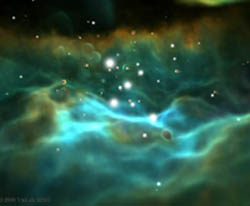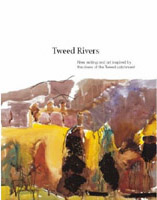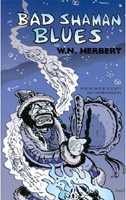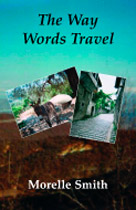W.N. Herbert
Travelling Songs
Travelling and wayfaring are two of the themes that each of these poetry publications share, with reflections on the physical and spiritual journeys that we all make in the course of our lives.
 The seasoned traveller and critical observer Tom Bryan, who began his life journey in Canada, maps his own travels in Rattlesnake Road. Not a sentimental record of the places he has visited, far less a gazetteer recommending pretty spa-towns where one might lay one’s head, Bryan’s work is created from more visceral experiences: ‘I’ve kissed ditches, man,/used drain pipes for pillows,/snored under dying stars./Counted Orion down and out/in the cat-slippered sunrise./And where the road met the moon,/I pissed human steam on frozen stone,/kept moving to starve the cold,/colliding with the sun/as it called forth serpents/to share my journey.’ Despite the harshness of some of these images, Bryan’s ‘road poems’ are not bitter: they are celebrations of his travels across Russia and the USA: in Tula, Yasnaya Polnaya and Moscow, Montana, the Rattlesnake of the title, and what has become the international village of New York. Indeed, one of the four sequences in this collection is entitled ‘San Francisco to Selkirk’. (Everyone has to come to journey’s end somewhere, and Selkirk is as good a place as any other to end, or to start.) Alongside this mapping of his own travels, Bryan also reflects on the journeys that others – exiles, political refugees, displaced people – have had to make. He writes in ‘Diaspora’ about various noble types he has met in the US, ‘these men and women never bought,/wore their dignity like well-washed tweed./Kept songs and stories deep within-/withheld gently from the melting pot.’ Better always to integrate than to assimilate. In ‘Tattoo’, he celebrates the kind Jewish woman, who ‘came to our door/when my mother came home to die’ with gifts of kosher food and tears and garden flowers. He remembers her ‘sleeve of blue./She worried it, pulling it down
The seasoned traveller and critical observer Tom Bryan, who began his life journey in Canada, maps his own travels in Rattlesnake Road. Not a sentimental record of the places he has visited, far less a gazetteer recommending pretty spa-towns where one might lay one’s head, Bryan’s work is created from more visceral experiences: ‘I’ve kissed ditches, man,/used drain pipes for pillows,/snored under dying stars./Counted Orion down and out/in the cat-slippered sunrise./And where the road met the moon,/I pissed human steam on frozen stone,/kept moving to starve the cold,/colliding with the sun/as it called forth serpents/to share my journey.’ Despite the harshness of some of these images, Bryan’s ‘road poems’ are not bitter: they are celebrations of his travels across Russia and the USA: in Tula, Yasnaya Polnaya and Moscow, Montana, the Rattlesnake of the title, and what has become the international village of New York. Indeed, one of the four sequences in this collection is entitled ‘San Francisco to Selkirk’. (Everyone has to come to journey’s end somewhere, and Selkirk is as good a place as any other to end, or to start.) Alongside this mapping of his own travels, Bryan also reflects on the journeys that others – exiles, political refugees, displaced people – have had to make. He writes in ‘Diaspora’ about various noble types he has met in the US, ‘these men and women never bought,/wore their dignity like well-washed tweed./Kept songs and stories deep within-/withheld gently from the melting pot.’ Better always to integrate than to assimilate. In ‘Tattoo’, he celebrates the kind Jewish woman, who ‘came to our door/when my mother came home to die’ with gifts of kosher food and tears and garden flowers. He remembers her ‘sleeve of blue./She worried it, pulling it down
…/silken shroud for her dark tattoo.’ As if redemptively, ‘each gift she ever made/ever given from her gentle hand,/caused that craven Auschwitz brand,/to softly blur, then finally fade.’ And in ‘Emigrants’, Bryan writes about a rare African stowaway moth, ‘blown airborne from/sweet-grass jungles’ and presented to the Royal Museum of Scotland by a relative of his after it came to land on these shores to ‘die on the clarted gable/of a council flat.’ His relative ‘often told me of that moth,/which also crossed oceans,/to sleep in gardens strange and cold.’
 Tweed Rivers, ‘a guidebook for the imagination, and for anyone who loves the rivers that flow into Tweed’ is a rich, imaginative publication itself, which brings together the work of contemporary poets, storytellers and visual artists. Inspired in part by E.V. Lucas’s 1899 anthology The Open Road: A little book for wayfarers, the current anthology extends the site-based work of the more recent Tweed Rivers Interpretation Project. ‘River catchments are not always obvious, but they shape identity and forge connections in ways that transcend politics’, and here the journey that the waters of the Tweed make from source to sea is given a different kind of permanency in words and images. Writing from established poets such as Gavin Bowd, Colin Donati and Valerie Gillies sits alongside the work of emerging writers. Dorothy Alexander’s fishy short story ‘Life is Sweet’, un-nostalgically recalling childhood, eulogises the Innerleithen trout, how to catch it and how to eat it, with the fingers, ‘with its coating of fried oatmeal’. Visual artists complement these interpretations in various media: etchings, woodcuts, watercolour and pinhole photography.
Tweed Rivers, ‘a guidebook for the imagination, and for anyone who loves the rivers that flow into Tweed’ is a rich, imaginative publication itself, which brings together the work of contemporary poets, storytellers and visual artists. Inspired in part by E.V. Lucas’s 1899 anthology The Open Road: A little book for wayfarers, the current anthology extends the site-based work of the more recent Tweed Rivers Interpretation Project. ‘River catchments are not always obvious, but they shape identity and forge connections in ways that transcend politics’, and here the journey that the waters of the Tweed make from source to sea is given a different kind of permanency in words and images. Writing from established poets such as Gavin Bowd, Colin Donati and Valerie Gillies sits alongside the work of emerging writers. Dorothy Alexander’s fishy short story ‘Life is Sweet’, un-nostalgically recalling childhood, eulogises the Innerleithen trout, how to catch it and how to eat it, with the fingers, ‘with its coating of fried oatmeal’. Visual artists complement these interpretations in various media: etchings, woodcuts, watercolour and pinhole photography.
In his eleventh collection, W.N. Herbert demonstrates with characteristic flair the versatility of his range, from short pieces to more extended sequences and prose-poems. Again, many of the works here concern themselves with impermanency, identity, history and change.
 The title-poem, ‘Bad Shaman Blues’, though very much a song of loss, transposes or transforms itself into a kind of elaborate bel canto, but in the Dundonian idiom. Also in that idiom is a little gem, ‘Macaroni Pie Fetish’ in which a translated ‘Miss Loren is waulkin doon/the Hilltoon in her birthday dress,/her ninepence hid ahent a macaroon/a pehcase clapped on ilka breist./It is in tribute to oor city/she’s macaroni on her titties,/and in a greasy Wellgate caff/her fans await tae lik it aff.’
The title-poem, ‘Bad Shaman Blues’, though very much a song of loss, transposes or transforms itself into a kind of elaborate bel canto, but in the Dundonian idiom. Also in that idiom is a little gem, ‘Macaroni Pie Fetish’ in which a translated ‘Miss Loren is waulkin doon/the Hilltoon in her birthday dress,/her ninepence hid ahent a macaroon/a pehcase clapped on ilka breist./It is in tribute to oor city/she’s macaroni on her titties,/and in a greasy Wellgate caff/her fans await tae lik it aff.’
Herbert is of course very much at home writing in Scots or in English. Although this collection happens to contains more in English than in Scots, it seems he has kept in reserve his best for the extended sequence ‘Rabotnik Fergusson’, a version of The Divine Comedy, itself a kind of travelogue. A dramatic meditation on both the status of Scottish poetry within the literary tradition and the place of poetry within the cosmos, it opens with the Edinburgh poet Robert Fergusson awaking ‘in Hell/or mebbe Heaven – wha can tell?’ with some robotic drone for his Virgil-like guide, except this one has a Dundee accent. On his travels through this hellish region, Fergusson meets the shades of other Scots poets and makars who are at this infernal place ‘fur thi sin/o verse that isnae Anglophone.’ The list of sinners is impressive: Blind Harry, the anonymous balladeers, one or other of the Wedderburns, Mark Alexander Boyd, Alexander Montgomery, James Hogg, the great William MacGonagall, and even a glisk of CMG himself. Those poets assigned speaking-parts rehearse their dooly fate to Fergusson, until in the ‘Song of the Index of the Spheres’, the destiny of all poetry is revealed, ‘dye ken there’s never hope o port?/we’re poems in a sea o prose.’ And in the final section, ‘Shanty of the Sailors’ Moon’, we learn, as Fergusson does at the conclusion of his odyssey, that as ‘we sail tae kingdom come’, all will end in silence.
This is a hugely inventive piece of writing: because he is writing about the Scots poetic tradition, Herbert resurrects the verse-form of the ‘Standard Habbie’, used by Ramsay, Fergusson and Burns, and by earlier poets before them. In a typical gesture of bravura, Herbert dedicates one section of the poem, ‘A Habbie History’, to this worthy stanza-form and eulogises the ‘Habbie’ using the stanza-form itself. ‘Here comes the bauld stanzaic lore/that maks aa modernistics snore:/a man caad Sempill fur a splore/wrote ‘Habbie Simson’,/a piper’s elegy – and more:/oor bards saw crimson.’ A verse-form peculiar to Scottish versification, the ‘Habbie’ has been regarded by some as artistically inferior to, say, the sonnet form. But the ‘Habbie’ is as versatile as any other form: ‘it’s hauf-lament and hauf in play/that gees the twist:/a fact that in his morbid lay/auld Wordsworth missed.’ And its use brings with it its own demands: ‘It maks ye rax for far mair rhymes/at a faster pace than the sad hauf-mimes/o normal formal verse: its chimes/can syncopate;/it’s bagpipe ragtime, bop’s sublime/Scots drinkin mate.’ This sustained use of the form to describe the form, in fact the entire poem, is something of a virtuosic feat and is entirely Herbert’s own contribution to the writing of the music, or the silence, of the spheres.
In Chagall Takes a Fall, the stuff of Thom Nairn’s poetry is based on the surreal transformation of the everyday: in ‘Palimpsest’, the landscape is lyrically defined by ‘slow snow down to patches on the hills/leaving only strange white alphabets’ from which emerge ‘bleak pylons as essential clefs’ which ‘turn this winter scenario/into a clean, original score’; and in ‘Visible Plum’, the sun is apocalyptically ‘a plum/Spiked on Scott’s spire./People on top/Lose landscapes in the dark./They quietly fry/Or just suffocate:/Depending/On how much they know.’ His poems are journeys too and take us from an Edinburgh bar to Dingwall in Ross-shire, back to the city’s Abbeymount and to Paris via Greece, where ‘the sun bares its teeth/at barred shutters./Noon is one thing/ (But there’s much to be said for Ouzo.)/The snarl of the Sun/is easily avoided/(with the aid of Ouzo.)/The big flat-calm/of the mind,/And the moon swallows me/(effortlessly, easy as Ouzo.)’
With Nairn’s publication comes a flyer, which reads: ‘Understanding Edinburgh Festival Fringe Events. You are invited to attend and to read your work at the 2006 Understanding Edinburgh Festival Fringe Events, at 1 Haymarket Terrace, EH12 5EY on 19 August at 7.30pm.’ Presumably the ticket price is included in the cost of the book.
 ‘I will wear soft colours, I resolve, lilac, sea-green, blue/as distance, the blue/that memory is made of.’ In The Way Words Travel, Morelle Smith writes eloquently about time and memory, place and displacement, and her travels between Scotland, France and Albania. Love too is part of Smith’s lexicon, though here it takes the form of a messenger as she recalls in the poem of that name this gift that, ‘gave me entry to a world/that is difficult to access,/even after years of searching…/slipping past the sentry posts/and entering a world/I’d always wanted to be in.’ On this metaphysical journey, ‘we fill this bag of light/with contents from our dreams/like eager pilgrims/setting out to find/the river’s source or destination,/quest-hungry/…and fill in destinations/like request slips for leave/of absence from our work./I don’t know the co-ordinates/of passage and arrival.’ Because this journey is uncertain, Smith ‘hazards guesses mostly/and often gets the answers/wrong; but the places/I end up in and the people/that I find there,/they are always right.’
‘I will wear soft colours, I resolve, lilac, sea-green, blue/as distance, the blue/that memory is made of.’ In The Way Words Travel, Morelle Smith writes eloquently about time and memory, place and displacement, and her travels between Scotland, France and Albania. Love too is part of Smith’s lexicon, though here it takes the form of a messenger as she recalls in the poem of that name this gift that, ‘gave me entry to a world/that is difficult to access,/even after years of searching…/slipping past the sentry posts/and entering a world/I’d always wanted to be in.’ On this metaphysical journey, ‘we fill this bag of light/with contents from our dreams/like eager pilgrims/setting out to find/the river’s source or destination,/quest-hungry/…and fill in destinations/like request slips for leave/of absence from our work./I don’t know the co-ordinates/of passage and arrival.’ Because this journey is uncertain, Smith ‘hazards guesses mostly/and often gets the answers/wrong; but the places/I end up in and the people/that I find there,/they are always right.’
In for a penny, in for a Pound. Despite his reportedly saying to Ginsberg towards the end of his days, ‘the worst mistake I made was that stupid, suburban prejudice of anti-Semitism’, Ezra Pound will be remembered as much for his crass stupidity as for ‘the long shadow his poetry has cast over literary modernism’. According to the poet and critic Michael Alexander, Pound was ‘the counsellor of Yeats, the discoverer of Eliot and the impresario of Joyce’; indeed Eliot regarded Pound as ‘the better craftsman’. But like Pound, Eliot too had peculiar, if not distasteful ideas about some things.
Ezra Pound in His Time and Beyond was produced to accompany an exhibition of the recently acquired Ezra Pound collection of the bookseller, collector, publisher and writer Robert A. Wilson, by the University of Delaware Library. It includes copies of Pound’s extremely rare first two publications, manuscripts, photographs and ephemera. Beautifully produced, it contains minuscule opuscules on the poet and his life, including Pound’s Own Influences and Forebears; William Carlos Williams and H.D.: The Penn Years; London, Yeats, Wyndham Lewis and Others; Joyce, Lawrence and Frost; ‘A Heap of Broken Images’: The Waste Land; The Paris Years; Pound and Little Magazines; The Cantos; World War II, The Pisan Cantos and St Elizabeths; and After Pound.
Pound was a traveller, and wayfarer, too. In his epigrammatic ‘Epitaph for Ezra Pound’, Michael Alexander quirkily expressed cognisance of this: ‘Ezra Pound/Got around:/He was born in Hailey,/But he was buried in San Michele.’
Rattlesnake Road, Tom Bryan, Dionysia Press (ISBN 1903171172, PBK £6.50); Tweed Rivers, edited by Ken Cockburn and James Carter, Luath Press (ISBN 1905222254, PBK £9.99); Bad Shaman Blues, W.N. Herbert, Bloodaxe Books (ISBN 1852242782, PBK £8.95); Chagall Takes A Fall, Thom Nairn, Dionysia Press (ISBN 1903171180, PBK £6.50); The Way Words Travel, Morelle Smith, UKA Press (ISBN 1904781462, PBK £7.99); Ezra Pound in His Time and Beyond: the influence of Ezra Pound on twentieth-century poetry, Jesse Rossa, University of Delaware Library (ISBN 097123602X, $10, contact ; Library Web: www.lib.udel.edu)
© Michael Lister 2006
Credit to the San Diego Supercomputer Center for the photo of the Orion nebula.

Comments